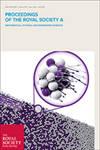Propagation through nonlinear time-dependent bubble clouds and the estimation of bubble populations from measured acoustic characteristics
Proceedings of the Royal Society of London. Series A. Mathematical and Physical Sciences
Pub Date : 2004-09-08
DOI:10.1098/rspa.2004.1298
引用次数: 102
Abstract
For several decades the propagation characteristics of acoustic pulses (attenuation and sound speed) have been inverted in attempts to measure the size distributions of gas bubbles in liquids. While this has biomedical and industrial applications, most notably it has been attempted in the ocean for defence and environmental purposes, where the bubbles are predominantly generated by breaking waves. Such inversions have required assumptions, and the state–of–the–art technique still assumes that the bubbles undergo linear, steady–state monochromatic pulsations in the free field, without interacting. The measurements always violate, to a greater or lesser extent, these assumptions. The errors incurred by the use of such assumptions have been difficult to quantify, but are expected to be most severe underneath breakers in the surf zone, where the void fraction is greatest. Very few measurements have been made in this important region of the ocean. This paper provides a method by which attenuation can be predicted through clouds of bubbles which need not be homogeneous, nor restricted to linear steady–state monochromatic pulsations. To allow inversion of measured surf zone attenuations to estimate bubble populations with current computational facilities, this model is simplified such that the bubble cloud is assumed to be homogeneous and the bubbles oscillating in steady state (although still nonlinearly). The uses of the new methods for assessing the errors introduced in using state–of–the–art inversions are discussed, as are their implications for oceanographic and industrial nonlinear bubble counters, for biomedical contrast agents, and for sonar target detection in the surf zone.通过非线性时变气泡云的传播和由测量的声学特性估计气泡群
几十年来,为了测量液体中气泡的大小分布,声脉冲的传播特性(衰减和声速)被颠倒了。虽然这在生物医学和工业上有应用,但最值得注意的是,它已经在海洋中用于国防和环境目的,其中气泡主要是由破碎的海浪产生的。这种反转需要假设,而最先进的技术仍然假设气泡在自由场中经历线性、稳态单色脉动,没有相互作用。测量总是或多或少地违反这些假设。使用这种假设所产生的误差很难量化,但预计在破碎体下面的冲浪区最严重,因为那里的空隙率最大。在海洋的这一重要区域进行的测量很少。本文提供了一种通过气泡云来预测衰减的方法,气泡云不需要是均匀的,也不局限于线性稳态单色脉动。为了利用当前的计算设备对测量的冲浪带衰减进行反演以估计气泡种群,该模型被简化为假设气泡云是均匀的,并且气泡在稳定状态下振荡(尽管仍然是非线性的)。本文讨论了新方法的用途,以评估使用最先进的反演所引入的误差,以及它们对海洋学和工业非线性气泡计数器、生物医学造影剂和冲浪区的声纳目标探测的影响。
本文章由计算机程序翻译,如有差异,请以英文原文为准。
求助全文
约1分钟内获得全文
求助全文
来源期刊
自引率
0.00%
发文量
0
期刊介绍:
Proceedings A publishes articles across the chemical, computational, Earth, engineering, mathematical, and physical sciences. The articles published are high-quality, original, fundamental articles of interest to a wide range of scientists, and often have long citation half-lives. As well as established disciplines, we encourage emerging and interdisciplinary areas.

 求助内容:
求助内容: 应助结果提醒方式:
应助结果提醒方式:


